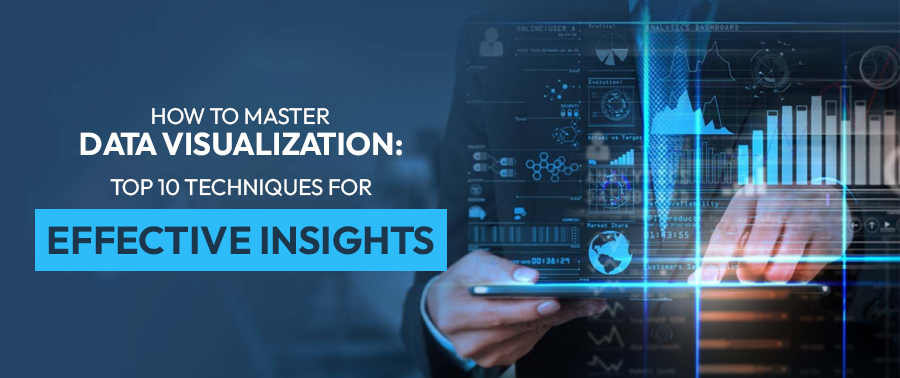Data has, over time, become the driving force behind modern decision-making. Whether you are a business analyst, researcher, or simply someone interested in unraveling the stories hidden within data, how you present it matters. The art and science of data visualization have emerged as an indispensable tool for transforming complex datasets into clear and actionable insights. This blog will take you on a journey through the top 10 data visualization techniques. These techniques bridge raw data and meaningful understanding, enabling you to communicate your findings effectively.
Let's get started!
1. Bar Charts:
Bar charts are one of the most straightforward and powerful tools for representing categorical data. The horizontal or vertical bars in a bar chart make it easy to compare different categories, as the length of each bar corresponds to the quantity or frequency of that category. These charts are widely used in various fields. They can help visualize sales performance across different products or regions in business. In research, they are essential for presenting survey results or demographic data. Bar charts can also be customized to stack or group bars, making them versatile for simultaneously showcasing multiple dimensions of data. However, when using bar charts, choosing appropriate color schemes and labeling is crucial to ensure clarity and effectiveness.
2. Line Charts:
Line charts are the go-to choice for visualizing trends and changes over time. They excel at displaying continuous data points like stock prices, temperature variations, or sales figures and connecting them with lines. The x-axis typically represents time or a continuous variable, while the y-axis represents the data's value. Line charts help identify patterns, fluctuations, or trends, making them invaluable for forecasting and understanding historical data behavior. For example, in financial analysis, line charts are used to track stock prices, while in environmental science, they can display long-term climate patterns. When creating line charts, emphasis should be placed on clearly labeling data points and axes and choosing line styles or colors for easy differentiation.
3. Scatter Plots:
This technique is indispensable for visualizing relationships between two continuous variables. Each data point in a scatter plot represents a specific observation, with one variable plotted on the x-axis and the other on the y-axis. Scatter plots are invaluable for identifying correlations, clusters, or outliers in data. For instance, in medical research, they can help identify potential connections between patient age and treatment effectiveness. In social sciences, scatter plots can visualize the relationship between income and education levels. Effective scatter plots require careful consideration of axis scaling, data point markers, and trend lines to enhance interpretability and insights.
4. Pie Charts:
This specific technique is suitable for illustrating the composition of a whole by dividing it into segments, where each segment represents a category's proportion. These charts are widely used to display market share, budget allocation, or demographic distributions. However, their effectiveness is contingent on the number of categories and the clarity of the data. Overly complex pie charts with numerous segments can become confusing and misleading. Thus, they are best suited for situations with a small number of distinct categories, and the emphasis is on relative proportions. When creating pie charts, it is crucial to order segments logically, use a consistent color scheme, and label each segment clearly.
5. Heatmaps:
Heatmaps are another widely used data technique, which is excellent for visualizing large and multidimensional datasets and effectively spotting patterns and trends. They represent data in a matrix format using colors, where each cell's color intensity corresponds to the data value it represents. Heatmaps are widely used in fields like genomics, finance, and web analytics for various purposes, including clustering, risk assessment, and user behavior analysis. Heatmaps facilitate the comparison of values by arranging data into rows and columns, making them valuable for identifying trends or anomalies. To create effective heatmaps, choosing an appropriate color palette, scale, and labeling is essential. Additionally, hierarchical clustering or sorting can help uncover underlying structures within the data.
6. Histograms:
Histograms are adequate for understanding the distribution of continuous data. They divide the data into discrete bins or intervals and specifically display the frequency or count of data points within each bin. Histograms are invaluable for assessing a dataset's shape, central tendency, and spread. For example, in quality control, histograms can be used to analyze product measurements, while educational assessments help evaluate test scores' distribution. Creating informative histograms requires selecting the right number of bins, choosing appropriate bin widths, and labeling axes. When assessing histograms, patterns such as normal distribution, skewness, or bimodality can be identified, aiding in data analysis and decision-making.
7. Box Plots:
Box plots, also known as box-and-whisker plots, are exceptional tools for summarizing and comparing data distribution across multiple groups or datasets. They display essential statistics in a compact format, including the median, quartiles, and potential outliers. Box plots are valuable in situations where understanding data's central tendency and variability is critical. In research, they can compare test scores among different schools, and in finance, they can analyze the distribution of investment returns across various assets. When creating box plots, it's essential to ensure that they effectively communicate the spread and central tendency of the data, identify potential outliers, and compare multiple box plots using the same scale for meaningful insights.
8. Tree Maps (150 words):
These are hierarchical data visualizations that excel at representing complex structures and hierarchical relationships within data. They are displayed as nested rectangles, with each level representing a category or subcategory. The size and color of each of the rectangles can convey additional information, making tree maps suitable for showcasing hierarchy and proportion. Tree maps are valuable in various contexts, such as visualizing organizational hierarchies, folder structures, or market segments. To create effective tree maps, defining a clear hierarchy and using colors and labels judiciously is crucial. Careful attention to the layout and readability ensures that the audience can navigate and understand the hierarchical structure and proportions being represented.
9. Sankey Diagrams:
Sankey diagrams are flow-based visualizations used to depict the distribution and flow of resources or quantities between different stages or categories. These diagrams are useful for understanding resource allocation, energy flows, and customer conversion paths. Each segment's width in a Sankey diagram corresponds to the quantity or value it represents, and the flow of resources is visually connected from one stage to another. In environmental analysis, Sankey diagrams can depict energy consumption and loss across various sectors, while in digital marketing, they can illustrate the user journey from ad click to conversion. Creating effective Sankey diagrams requires clear labeling, attention to proportional scaling, and ensuring that the diagram effectively conveys the flow and distribution of resources or values.
10. Word Clouds:
This technique creatively visualizes textual data by representing word frequencies through varying font sizes and colors. The more frequently a specific word appears in the overall text, the larger and bolder it appears in the word cloud. These visualizations are commonly used for summarizing and identifying prominent keywords or themes in large text corpora, such as customer reviews, survey responses, or social media comments. Word clouds make it easy to recognize recurring terms and emphasize the most critical aspects of the text. However, they should be used as a complementary tool alongside more quantitative analyses, as they do not provide detailed quantitative information.
Conclusion
Therefore, data visualization is essential for making sense of complex datasets and conveying insights effectively. Whether you are presenting data to stakeholders, conducting data analysis, or exploring trends, choosing the right visualization technique is crucial. The top 10 data visualization techniques discussed above offer a range of options to suit different data types and objectives. But, to become proficient in data visualization, it is important to choose the right technique and master the art of creating clear and compelling visualizations.





Top comments (0)